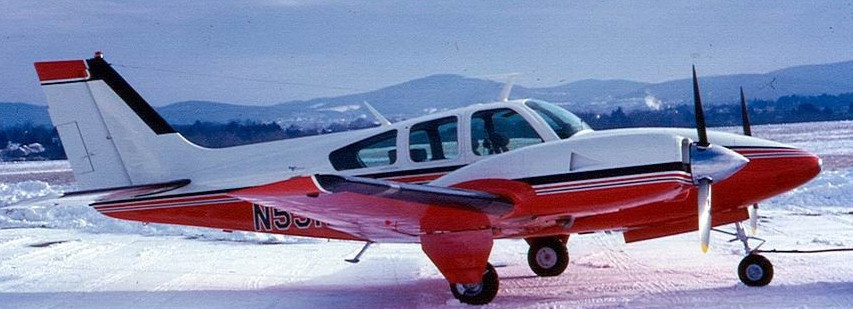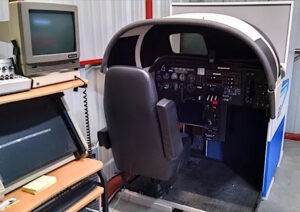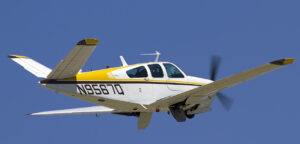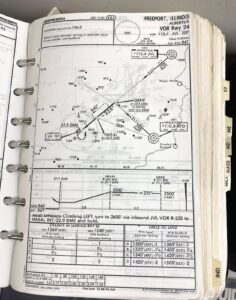1988
The next step
In the preceding two years, I had logged more than 300 hours flying my Mooney all over the country, in all kinds of weather, over all kinds of terrain, and into airports small and gigantic. I was itching to get back into the kind of experience I had in the Baron. And I was confident that I was ready. Time to find the right Baron.
Back when I was flying Dad’s Bonanza the dealer always had at least one Baron on hand for demonstrations. One time it was not an ordinary Baron – it was a Turbo Baron. In the fifties if a kid wanted to soup up his Chevy, he’d find a way to install a gigantic Caddy engine under the hood. And it would blow the doors off anything his buddies could offer.
Beechcraft had done the same thing with their line of Barons. A basic Baron (A or B model) had two 260 horsepower engines; the stepped up model (C, D or E) had 285. They were both among the fastest mainstream planes at the time. But in 1966, Beech introduced the Turbo Baron with twin turbocharged 380 horsepower engines. And it was a hot rod. Even from across the ramp, the huge engine nacelles made it clear this was no ordinary Baron. And when running, you heard their deep-throated growl – just begging to show their teeth in the air.
The performance numbers reflected this power. The Turbo Baron could climb more than 2,000 fpm (24mph vertical), cruise at 250 knots (287 mph), and fly above 32,000 feet (six miles up).
The search was on. And it took me to John Wayne Airport in Santa Ana, California. I had learned my lesson about pre-purchase inspections when I bought the Mooney so this time I asked Gary Seabert, a Beechcraft expert, to come with me to check it out. An inspection of the plane and its logbooks revealed nothing scary so we headed up to the abandoned control tower that had become the seller’s office and closed the deal.

Time to fire it up and head home. Although the plane was well able to fly more than 30,000 feet up, we chose to stay at more breathable altitudes for several reasons. First, the lower altitudes were kinder to the engines – and Gary wisely thought we should monitor their behavior under less demanding conditions. Second, although the plane had ample oxygen on board, we had no masks to use it. But the clincher was the heater – it didn’t work. And the outside air temperature at high altitude was a numbing minus 30 degrees!
Recurrent training
Since my only multi-engine flying in two years was the trip back from California, the first thing I sought was a thorough refresher. Recurrent Training Center in Champaign, Illinois offered a two-day simulator course that promised to shake out the cobwebs and prepare me for most any emergency.

For two days, I flew in a box – or rather an AST-300 flight training device. The beauty of simulator training is it’s possible to practice emergencies that would be unsafe in an airplane. And the experience feels very real. I’m told that one pilot lost control and screamed when the simulator crashed.
Initially, all I had to do was learn to fly the sim. But just as I began feeling confident, the instructor failed an engine. I crashed and burned. He pressed the reset button and I died again. A curious thing about an engine failure in a twin is that although the plane tends to yaw toward the failed engine, that yaw causes it to roll over. That’s a bad thing.
About the sixth time, I got the hang of it. At the first sign of a failure, the memorized check list popped into my head:
- Fly the plane (keep it under control)
- Identify (the failed engine)
- Verify (before shutting down a good engine)
- Feather (minimize the adverse yaw)
- Wind my watch (take a deep breath and methodically follow the written checklist)
It became kind of fun.
Engine failure was only the first emergency we practiced. In one lesson the instructor stopped talking. Acting as , he was simulating lost communications. I had to find my way to a safe landing without bumping into mountains, buildings or other airplanes … and do it with no help from anyone outside the plane.
Over two days and eight hours in the simulator something was always going wrong. When I flew home in a real airplane, I could hardly believe things worked as they should.
A big trip to Florida
Having brought my flying skills back up to par, I took Jeff on a trip to Florida. After a nice visit with my parents in Orlando, we hopped over to Titusville to pick up Uncle Leland for the ride back to Chicago. The Titusville tower controller cleared me to land, but as I neared the runway he crisply commanded, “November five five romeo alpha, go around.”
Although I was baffled as to why he wouldn’t let me land – there wasn’t another plane within miles, and I couldn’t see any alligators on the runway – I immediately complied. Questions could come later.

Back at a safe altitude, I asked what gives. The controller informed me that my wheels were only half way down. If I had landed they would certainly have collapsed. Jeff and I would have been safe, but both of the props and engines would have been destroyed – a loss greater than the value of the plane. I circled, recycled the landing gear and checked everything I could from inside the plane, then flew by the control tower so the controller could take a close look. Convinced that it was only a one time quirk, I landed without a hitch.
While Uncle Leland and Jeff chatted, I went to the pilot lounge to finish planning the flight to Chicago. Then we packed up and headed north for our planned fuel stop in Louisville.

Before iPads stored all the airports in the world, pilots carried a twenty pound flight bag with eight binders full of navigation charts. For this trip I needed the southeast and midwest. As we worked our way north through Georgia, I turned to 8-year-old Jeff in the back seat and asked him to give me the binder for the midwest. It included everything from Kentucky north to home. And we would need the charts to make an instrument approach at Louisville.
Jeff: It’s not here, Dad.
Me: It must be. Look again.
Jeff (having looked everywhere he could in the second and third rows of seats and feeling like he might be disappointing me): I can’t find it.
60-year-old Leland then crawled over all the seats with the same results. We concluded I must have left it in Titusville. Time to improvise. Although I had been to Louisville a few times, I wasn’t about to make an instrument approach without all of the details right in front of me. We could stop in Crossville, TN, for which I had the charts, then continue to Palwaukee where the weather was better and I could do the approach in my sleep.

When we arrived in Crossville, the ramp attendant greeting me in a way I never expected, “Did you ever get the heater fixed on that plane?” Whereupon I recalled that when we bought the plane in Southern California, the logbooks revealed that it had lived in Tennessee for a while and had its maintenance done in Crossville. And NO the heater still didn’t work!
We bought and paid for the gas and the folks behind the counter asked if there’d be anything else that evening. Something about the way they phrased it seemed a bit odd … but we headed out to the plane for our final leg home.
Before every flight I do a preflight inspection – even if I only stopped for fuel. And I always secured the fuel caps and checked the oil on both engines. The oil was at the low end of OK, so I decided to add a quart. That’s when I discovered why they wanted to know if I needed anything else: They had turned out the lights and gone home!
No problem – the oil wasn’t really low – it was at 12 quarts instead of full up at 13. So we climbed in and buckled up.

By this time it was dark outside so I grabbed my Maglite to find the slot for the key. Click. Snap. The light bulb light burned out. But I was prepared. The Maglite had a spare bulb in the bottom. In the dark I disassembled it, replaced the tiny bulb, and reassembled it. And it shone brightly. Yea!
As I reached over to insert the key, a new light bulb went off in my head: We left a book of charts in Titusville … We made an unplanned landing … It was now after dark … The oil was on the low end of acceptable … I was going to have to land at Palwaukee … at night … with no approach plates in hand. Is God telling me that if I go on, He’s not going with me?!
We found a motel and flew home the next morning. The skies were clear. The sun shone bright. And I was terribly proud of myself for having made a difficult but wise decision.
* * *
Questions or comments? Please leave a reply below. I’d love to hear from you.
Any problems? Email me at grandpalylesnotebook@gmail.com
Total flying time to date: 1,010 hours
New types: Beechcraft BE 56TC Turbo Baron, AST-300 Flight Training Device
New ratings: None